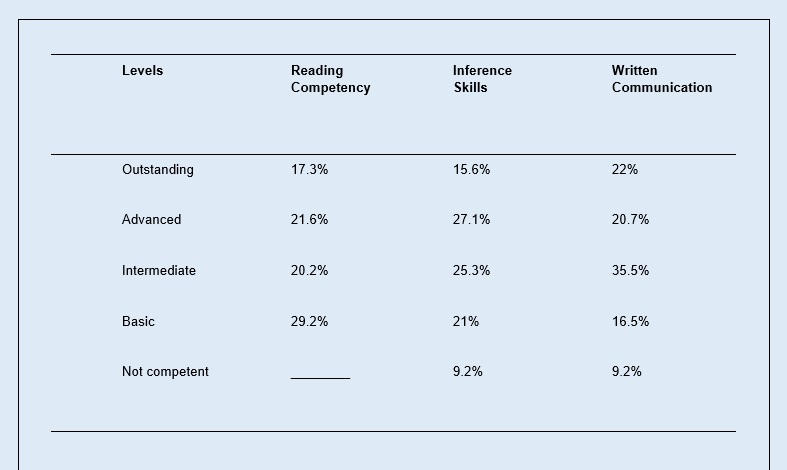With the aim of improving reading and writing, fundamental competences that are evaluated by the OECD and the PLANEA test, a group of teachers of Social Sciences, Literature, and Arts developed research that they could use as material for their classes. The texts had a positive impact among the students and the activity allowed the teachers to enhance their research skills.
By Corina Guadalupe Chávez Martínez
cgchavez@itesm.mx
Teacher, I didn’t understand… but I did read it, I promise! Does that sound familiar? It is a common expression among students in the classroom, but what does it really imply? This is precisely the issue this article addresses.
To which historiographic trend does reading belong? What is its thesis? Is it a primary or a secondary source? These, among others, are the favorite questions of history teachers whose aim is for students to analyze and question reading matter, when the reality is that a large part of the student body cannot answer the simple question, what was the reading about?
I read, but I didn’t understand…
During the August-December 2015 semester, a group of teachers of the high school course Contemporary Society in the 19th Century, administered a series of reading exercises to 141 students, to assess their reading competency and written communication levels. Then, using a sample of 47 students (1/3 of the total), we reached the conclusion that 61.7% of them did not understand the content of the reading matter, and were rated at the basic level of competence. The results also showed that 97.9% of students are positioned in the intermediate and basic levels of competence in written communication.
data-animation-override>
“Reading and writing are basic skills for learning that are evaluated by the OECD and the PLANEA test.”
This was a major issue, since reading is the means through which formal knowledge is received and permits education by means of a complex process that involves attention, concentration and reflection, thus facilitating the analysis of ideas, abstract concepts and improved spelling. These are all necessary elements for educational development, which is why the OECD and the PLANEA test classify reading and writing as basic competencies.
Moreover, by the end of the course, students were expected to have developed research skills based on Social Science methodologies, gained insight into academic rigor in diverse sources and interpretations, and be able to analyze critically and analytically the history of Mexico and the United States of America, as well as universal history, seeking their interconnections to avoid a fractured history that was alien to students. This resulted in new difficulties, since none of the textbooks offered in the market matched these requirements.
data-animation-override>
“To face these problems, as teachers we proposed the development of research articles made by ourselves in order to be used as class material.”
Therefore, as educators, the solution we proposed to these issues was for us to write research articles to be used as class materials. We formed a team with nine professors from the departments of Social Sciences, Spanish, and Literature and Art from the Estado de México and Ciudad de México campuses of Tecnológico de Monterrey. After selecting the topics, we began our research for the articles on Universal, Mexican and US history. At the same time, we completed a Writing and Spelling training course in order to improve our written communication. Finally, with a total of fifteen articles which, after being assessed by expert reviewers, were placed in the institutional repository, making them available to not only to students, but also other faculty members. The objectives of these articles were to:
- a. Have specialized texts, created with scientific rigor.
- b. Foment reading comprehension and written communication among students.
- c. Drive historical research among educators, encouraging them to stay current within their fields of specialization.
- d. Build knowledge, incorporating new information and developing creative, innovative teaching strategies, thus making it possible to stay constantly up to date.
- e. Facilitate students’ access to specialized, current bibliography.
- f. Foster the participation of teachers in collegiate, comprehensive projects, thus supporting institutional management.
We began using the articles as class materials in the January-May 2016 semester and, with a sample of 139 students, we were able to confirm considerable progress, as can be seen in the following table:
Results of the implementation of the research articles.
Source: Chávez C. Implementation report. NOVUS 2015. ITESM. 2015
In the results table, we can see that the articles had a positive impact among students, fomenting reading comprehension and written communication, which can be confirmed by comparing the results obtained at the start of the semester in the diagnostic exam, administered to students in 2015. In the same way, writing the articles allowed the teachers to develop their research skills, an indispensable element for teaching on the basis of their own experience, which contributed to their updating within their field of specialization.
About the author
Corina G. Chávez Martínez holds a Master’s in the History of Mexico from the Faculty of Philosophy and Arts, UNAM. She is a High School Professor with the Department of Social Sciences of Tecnológico de Monterrey, Campus Estado de México.
This article from Observatory of the Institute for the Future of Education may be shared under the terms of the license CC BY-NC-SA 4.0 
)
)



)